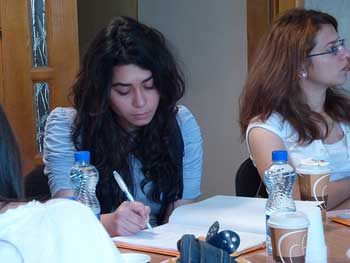Almost any two texts can be read intertextually, but if the theme of one text is similar to the theme of another text, the two texts will fit together and enhance each other more naturally. The two texts you will read in this lesson may seem to have nothing in common at first. “The Runaway” is a poem about a colt terrified by its first experience of snow. The other is a chapter from the novel Kidnapped about a boy stranded on an island, refused help by a passing boat.
Read the two texts carefully and annotate them to help you understand what they are saying. (You might want to look at Annotating for Meaning in the Related Resources to get ideas about how and what to mark.)

Source: Training participant takes notes during
RROGRAEK training session, The Advocacy Project, Flickr
Hint #1: You should probably read the “The Runaway” text first. You will be able to keep the ideas of the shorter text in your mind more easily while you read the second text from Kidnapped than if you did it the other way around.
Hint #2: Annotate (i.e., underline, circle, and make marginal notes) as you read to help you connect ideas in the two texts when you’re finished reading.
Hint #3: Everyone has his or her own way to annotate a text, but since this lesson is focused on reading and making connections between two texts, you might consider the following paired-passage annotation strategy:
- Read the short text carefully without marking anything or writing marginal notes.
- Read the longer text marking details, ideas, and actions that could connect this text with the shorter first text.
- Return to the first text and mark ideas, details, and actions that connect to the second text.

Source: Sunday reading, smohundro, Flickr
Whatever notation strategy you use, look for elements of the poem and the story that are similar and could be useful when writing about the two texts.